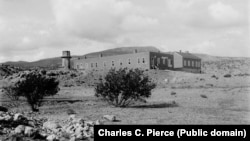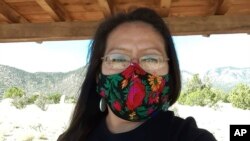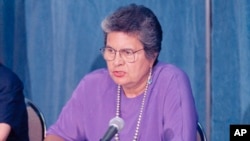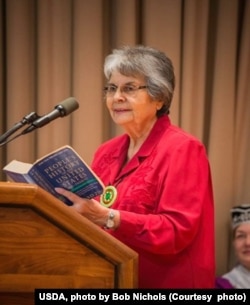Native Americans
Native American News Roundup Aug. 27-Sept. 2, 2023

Here are some Native American-related news stories that made headlines this week:
New count of Indian Boarding Schools: 523 and likely growing
The National Native American Boarding School Healing Coalition (NABS) this week released an interactive digital map identifying 523 Indian boarding schools across the United States. That’s 115 more than were identified in the Federal Indian Boarding School Initiative Investigative Report of May 2022 that counted Indian boarding schools operated, funded, or supported by the U.S. government.
The new map includes both federally operated boarding schools and institutions run by various religious entities. It also identifies known residential schools in Canada.
The project has been three years in the works, and the group’s Deputy CEO Samuel Torres (Mexica/Nahua) expects more schools will come to light.
“I believe this tool is going to greatly help our relatives who are seeking answers and who are on their own healing journeys,” he said in a statement. “Every Indigenous person in this country has been impacted by the deliberate attempt to destroy Native families and cultures through boarding schools. For us to visually see the scope of what was done to our communities and Nations at this scale is overwhelming, but this work is necessary to uncover the truth about this dark chapter in American history.”
Native News Online reports that NABS is hoping to launch a database in November containing nearly 50,000 records collected from boarding and residential schools.
Read more:
University professor and accused ‘pretendian’ resigns
Andrea Smith, once a well-regarded scholar of Native American studies, has agreed to resign from the University of California at Riverside after more than a decade of accusations that she falsely claimed Cherokee identity.
VOA obtained a copy of the separation agreement signed by Smith in January 2023 and by university chancellor Kim Wilcox in December 2022. It states that Smith will teach through the summer of 2024 and will then retire as a professor emeritus with the following stipulation:
“Professor Smith agrees that her status as a professor emeritus will not be listed on the university directory information websites.”
In addition, the university will pay her related legal fees up to $5,000.
As VOA has reported previously, Native American scholars say ‘race shifting’ is prevalent in universities across North America. In a 2022 interview with VOA, Kim TallBear, (Sisseton Wahpeton Oyate) a professor at the University of Alberta, explained why the practice is harmful:
"Non-Indigenous people with non-Indigenous community standpoints who pose as Indigenous and who rise through the professional ranks falsely represent our voices," TallBear said. "They theorize Indigenous peoplehood, sovereignty and anti-colonialism. They become thought leaders, institutional decision-makers and policy advisers to governmental leaders with regulatory and economic power over our peoples and lands."
Read more:
Native American Church to Washington: Protect our Peyote
The Native American Church of North America (NACNA) will next month hold a second “boots on the ground” effort in Washington, calling on federal agencies and lawmakers to help protect peyote from the effects of climate change, corporate agriculture and so-called “drug tourism.”
“We will remind federal government agencies that laws established by them in 1978 and 1994” allow Native American Church member to “exercise our rights,” church president Jon Brady posted to members on Facebook.
Peyote is a small, button-shaped cactus that contains psychoactive alkaloids and grows only in southern Texas and parts of northern Mexico. Indigenous people have used it ceremonially and medicinally for centuries.
It was banned in the United States in 1970, but the law was later amended to allow its use in “bona fide religious ceremonies of the Native American Church.”
Cherokee Nation boosts TV and film production
The Cherokee Nation has launched a new media company to consolidate its existing Cherokee Film Productions, Cherokee Film Studios, Cherokee Film Commission, and Cherokee Film Institute.
The new Cherokee Film company will continue sharing the tribe's stories through OsiyoTV and is planning new projects to tell Cherokee stories and boost the revitalization of the Cherokee language.
“Cherokee Nation has quickly become a leading hub for Indigenous storytellers in television and film,” Cherokee Nation Principal Chief Chuck Hoskin Jr. said in a statement. “As we increase infrastructure, explore incentives, connect resources and remove barriers, Cherokee Nation and its businesses are helping grow and amplify television and film production in Oklahoma while making it possible for our citizens to be a part of it.”
Read more:
You can watch Cherokee Film’s documentary series Osiyo: Voices of the People, here:
Pacific Northwest tribes welcome Polynesian navigators
Hōkūle'a, a traditional Polynesian deep-sea canoe, is on a four-year voyage around the Pacific Ocean to raise awareness about climate change.
The canoe sailed into Elliott Bay in Seattle, Washington, early Wednesday morning, escorted by traditional Suquamish canoes with Muckleshoot and Hawaiian canoes there to greet them.
VOA correspondent Natasha Mozgovaya was there and filed this report:
Tribal Courts Across US Expanding Holistic Alternatives to Criminal Justice System

Inside a jail cell at Laguna Pueblo in New Mexico, Albertyn Pino's only plan was to finish the six-month sentence for public intoxication, along with other charges, and to return to her abusive boyfriend.
That's when she was offered a lifeline: An invitation to the tribe's Healing to Wellness Court. She would be released early if she agreed to attend alcohol treatment and counseling sessions, secure a bed at a shelter, get a job, undergo drug testing and regularly check in with a judge.
Pino, now 53, ultimately completed the requirements and, after about a year and a half, the charges were dropped. She looks back at that time, 15 years ago, and is grateful that people envisioned a better future for her when she struggled to see one for herself.
"It helped me start learning more about myself, about what made me tick, because I didn't know who I was," said Pino, who is now a case manager and certified peer support worker. "I didn't know what to do."
The concept of treating people in the criminal justice system holistically is not new in Indian Country, but there are new programs coming on board as well as expanded approaches. About one-third of the roughly 320 tribal court systems across the country have aspects of this healing and wellness approach, according to the National American Indian Court Judges Association.
Combining legal advocacy and support
Some tribes are incorporating these aspects into more specialized juvenile and family courts, said Kristina Pacheco, Tribal Healing to Wellness Court specialist for the California-based Tribal Law and Policy Institute. The court judges association is also working on pilot projects for holistic defense — which combine legal advocacy and support — with tribes in Alaska, Nevada and Oklahoma, modeled after a successful initiative at the Confederated Salish and Kootenai Tribes in Montana.
"The thought and the concept will be different from tribe to tribe," said Pacheco. "But ultimately, we all want our tribal people ... to not hurt, not suffer."
People in the program typically are facing nonviolent misdemeanors, such as a DUI, public intoxication or burglary, she said. Some courts, like in the case of Pino, drop the charges once participants complete the program.
A program at the Port Gamble S'Klallam Tribe in Washington state applies restorative principles and assigns wellness coaches to serve Native Americans and non-Natives in the local county jail, a report released earlier this year by the John D. and Catherine T. MacArthur Foundation outlined. The Muscogee (Creek) Nation in Oklahoma has a reintegration program that includes financial support and housing services, as well as cultural programming, career development and legal counsel. In Alaska, the Kenaitze Indian Tribe's wellness court helps adults in tribal and state court who are battling substance abuse and incorporates elements of their tribe's culture.
"There's a lot of shame and guilt when you're arrested," said Mary Rodriguez, staff attorney for the court judges association. "You don't reach out to those resources, you feel that you aren't entitled to those resources, that those are for somebody who isn't in trouble with the law."
'You are better than the worst thing you've done'
"The idea of holistic defense is opening that up and reclaiming you are our community member, we understand there are issues," Rodriguez said. "You are better than the worst thing you've done."
The MacArthur Foundation report outlined a series of inequities, including a complicated jurisdictional maze in Indian Country that can result in multiple courts charging Native Americans for the same offense. The report also listed historical trauma and a lack of access to free, legal counsel within tribes as factors that contribute to disproportionate representation of Native Americans in federal and state prisons.
Advocates of tribal healing to wellness initiatives see the approaches as a way to shift the narrative of someone's life and address the underlying causes of criminal activity.
There isn't clear data that shows how holistic alternatives to harsh penalization have influenced incarceration rates. Narrative outcomes might be a better measure of success, including regaining custody of one's children and maintaining a driver's license, said Johanna Farmer, an enrolled citizen of the Rosebud Sioux Tribe in South Dakota and a program attorney for the court judges association.
Some tribes have incorporated specific cultural and community elements into healing, such as requiring participants to interview their own family members to establish a sense of rootedness and belonging.
"You have the narratives, the stories, the qualitative data showing that healing to wellness court, the holistic defense practices are more in line with a lot of traditional tribal community practices," Farmer said. "And when your justice systems align with your traditional values or the values you have in your community, the more likely you're going to see better results."
While not all of these tribal healing to wellness programs have received federal funding, some have.
Between 2020 and 2022, the U.S. Department of Justice distributed more than a dozen awards that totaled about $9.4 million for tribal healing to wellness courts.
This year, the Quapaw Nation in Oklahoma started working on a holistic defense program after seeing a sharp increase in cases following a U.S. Supreme Court ruling that said a large area of eastern Oklahoma remains a Native American reservation.
So far this year, about 70 cases have been filed, up from nearly a dozen in all of 2020, said Corissa Millard, tribal court administrator.
"When we look at holistic approaches, we think, 'What's going to better help the community in long term?'" she said. "Is sending someone away for a three-year punishment going to be it? Will they reoffend once they get out? Or do you want to try to fix the problem before it escalates?"
For Pino, the journey through Laguna Pueblo's wellness court wasn't smooth. She struggled through relapses and a brief stint on the run before she found a job and an apartment to live in with her son nearby in Albuquerque, New Mexico. Her daughters live close by.
She largely credits the wellness court staff for her ability to turnaround her life, she said.
"They were the ones that stood by me, regardless of what I was choosing to do; that was the part that brought me a lot of hope," she said. "And now where I'm at, just to see them happy, it gets emotional, because they never let go. They never gave up on me."
Native American News Roundup Aug. 13-19, 2023

Here are some of the Native American-related stories that made headlines this week:
Native Hawaiians missing, dead or displaced by Maui wildfires
Native Hawaiians – the Kānaka Maoli – are struggling to comprehend the devastation caused by wildfires in Maui, last week. At least 111 people – including children – are dead, and that number is expected to rise as the search for remains continues.
Hawaii Gov. Josh Green told CNN on Wednesday that “probably over 1,000” residents are still missing.
The fire, which broke out August 8, devastated the community of Lahaina, leaving thousands of people unhoused. Lahaina, an important Native Hawaiian cultural center, was between 1820 and 1845 the capital of the Kingdom of Hawaii. Officials say it will cost more than $5.5 billion to rebuild.
Read more:
Biden administration injecting funds into tribal clean energy programs
The Department of the Interior this week announced a new program that will initially make available $72.5 million to help Native American communities bring clean energy to tribal homes.
An estimated 17,000 tribal families live without electricity, most of them in the Southwest and Alaska. The Tribal Electrification Program will provide money and expertise to help tribes electrify homes using environmentally friendly energy sources.
It will also help homes that already have electricity switch to cleaner energy options and provide support for home repairs and changes needed to make this happen.
The new funding announcement is part of an overall $150 million investment from the Inflation Reduction Act to support the electrification of homes in tribal communities.
“Climate change is the crisis of our lifetimes and has left far too many communities managing for worsening water challenges, extreme heat, devastating wildfires and unprecedented storms. Every action we take now to lessen the impacts for future generations is critical,” Interior Secretary Deb Haaland said.
“Through President [Joe] Biden’s Investing in America agenda, we’re launching a new program to electrify Indian Country to provide reliable, resilient energy that Tribes can rely on, and advance our work to tackle the climate crisis and build a clean energy future.”
Read more:
Interior Department to fund water systems in drought-ridden Upper Colorado River Basin
In a related story, the Department of the Interior this week also announced it will make available $50 million over the next five years to improve key water supply systems and drought-related data collection across the Upper Colorado River Basin.
“The Biden-Harris administration is committed to bringing every tool and every resource to bear to as we work with states, Tribes and communities throughout the West to find long-term solutions in the face of climate change and the sustained drought it is creating,” Deputy Secretary Tommy Beaudreau said.
“As we look toward the next decade of Colorado River guidelines and strategies, we are simultaneously making smart investments now that will make our path forward stronger and more sustainable.”
Read more:
Celebrated Menominee activist Ada Deer dies
Ada Deer, the first woman to lead the Interior Department’s Bureau of Indian Affairs, died on Tuesday at the age of 88.
A well-known champion for Native American rights and sovereignty, Deer grew up on the Menominee Indian Reservation in Keshena, Wisconsin. After earning her bachelor’s and master’s degrees, she worked as a social worker in New York and Wisconsin.
In 1954, during the so-called “Termination Era,” Congress withdrew its recognition of the Menominee tribe, which meant their lands were now under state control and up for development. It also meant the tribe lost all federal benefits, such as health care and education, and was plunged into poverty.
In the early 1970s, Deer and other Menominee supporters launched a grassroots movement — Determination of Rights and Unity of Menominee Shareholders, or DRUMS — in protest, and took their case to Washington.
“You don’t have to collapse just because there’s a federal law in your way. Change it,” she told The Washington Post in 1973.
In late 1973, President Richard Nixon signed the Menominee Restoration Act, reinstating the tribe’s protected status and benefits.
President Bill Clinton in 1973 appointed her assistant secretary for Indian Affairs at the Interior Department, overseeing the Bureau of Indian Affairs.
Read more:
Federal judge in Wisconsin upholds tribe’s sovereignty over roadways
A federal judge this week dismissed a lawsuit that aimed to force the Lac du Flambeau Tribe in Wisconsin to remove road barricades it had put in place in January.
The blocked roads were built on tribal land in the 1960s and are the only route in and out for non-Natives living on the reservation. Land agreements allowing them to use the roads expired in 2013, and negotiations to extend them have so far failed. The Lac du Flambeau Tribal Council says it is owed $20 million for trespassing on its land since the easements expired.
A group of non-tribal residents in February filed suit against the 12-member tribal council. The court held oral arguments June 7, 2023, and on Tuesday, U.S. District Judge William Conley dismissed the lawsuit altogether, acknowledging tribal sovereign rights over the roads, a matter over which federal courts lack jurisdiction.
Read more:
Native American Journalists Association rebrands
Members of the Native American Journalists Association have voted to change the organization’s name to the Indigenous Journalists Association (IJA).
They voted 89 to 55 in favor of the change during their annual conference, which was hosted in Winnipeg last week.
Francine Compton, IJA associate director, said the move was made to match international language and to ensure all First Nations, Metis, Native American and Inuit journalists are included and supported.
"It means a whole lot to me, that I can now have this organization with a name where people in my own community can look at it and say, 'That's for me,'" said Compton, who is Anishinaabe from the Sandy Bay Ojibway First Nation, 131 kilometers northwest of Winnipeg.
The organization also updated the logo from NAJA with a feather to a stylized “IJA,” above.
Read more: https://www.cbc.ca/news/indigenous/indigenous-journalists-association-1.6937231
Ada Deer, Influential Native American Leader, Dies at 88

Ada Deer, an esteemed Native American leader from the U.S. state of Wisconsin and the first woman to lead the U.S. Bureau of Indian Affairs, has died at age 88.
Deer passed away Tuesday evening from natural causes, her godson Ben Wikler, chair of the Democratic Party of Wisconsin, confirmed on Wednesday. She had entered hospice care last month.
Trailblazer, advocate
Born August 7, 1935, on the Menominee reservation in Keshena, Wisconsin, Deer is remembered as a trailblazer and fierce advocate for tribal sovereignty. She played a key role in reversing Termination Era policies of the 1950s that took away the Menominee people's federal tribal recognition.
"Ada was one of those extraordinary people who would see something that needed to change in the world and then make it her job and everyone else's job to see to it that it got changed," Wikler said. "She took America from the Termination Era to an unprecedented level of tribal sovereignty."
Deer was the first member of the Menominee Tribe to graduate from the University of Wisconsin-Madison and went on to become the first Native American to obtain a master's in social work from Columbia University, according to both schools' websites.
In the early 1970s, Deer organized grassroots political movements that fought against policies that had rolled back Native American rights. The Menominee Tribe was placed under the control of a corporation in 1961, but Deer's efforts led President Richard Nixon in 1973 to restore the tribe's rights and repeal termination policies.
Soon after, Deer was elected head of the Menominee Restoration Committee and began working as a lecturer in American Indian studies and social work at the University of Wisconsin. She unsuccessfully ran twice for Wisconsin's secretary of state and in 1992 narrowly lost a bid to become the first Native American woman elected to U.S. Congress.
President Bill Clinton appointed Deer in 1993 as head of the Bureau of Indian Affairs, where she served for four years and helped strengthen federal protections and rights for hundreds of tribes.
She remained active in academia and Democratic politics in the years before her death and was inducted into the National Native American Hall of Fame in 2019.
Earlier this month, Governor Tony Evers proclaimed August 7, Deer's 88th birthday, as Ada Deer Day in Wisconsin.
"Ada was one-of-a-kind," Evers posted Wednesday on X, the platform formerly known as Twitter. "We will remember her as a trailblazer, a changemaker, and a champion for Indigenous communities."
Native American News Roundup August 6-12, 2023

Here are some Native American-related news stories that made headlines this week:
New national monument will curb, not halt, uranium mining near Grand Canyon
President Joe Biden was in Arizona on Tuesday, where he designated more than 404,000 hectares of land around the Grand Canyon as a national monument, the fifth of his presidency.
America’s natural wonders are our nation’s heart and soul,” Biden said, speaking at Red Butte Airport in Williams, Arizona. “And so, today, I’m proud to use my authority under the Antiquities Act to protect almost 1 million acres of public land around Grand Canyon National Park as a new national monument, to help right the wrongs of the past and conserve this land of ancestral footprints for all future generations.”
The monument will now be known as Baaj Nwaavjo l’tah Kukveni Grand Canyon National Monument. The name is a blending of the languages of two tribes, the Havasupai and Hopi, who are among more than a dozen tribes whose ancestors made their home here. See video below to understand more about the name.
In 2012, the Interior Department enacted a 20-year moratorium on any new uranium mining around the Grand Canyon. Mining operations in the area that predate that moratorium will be allowed to continue.
VOA’s Matt Dibble filed this story:
Group calls on Washington football team to ‘Reclaim the Redskins’
Name changes are on the agenda of another group this week: the Native American Guardians Association (NAGA) sent a three-page letter to the owners and leaders of the Washington Commanders football, calling on them to change the team’s name back to the “Washington Redskins.”
According to the letter posted on the NAGA Facebook page, the group aims “to stop the further cancel culture” against Native Americans.
“As you are undoubtedly aware, the Redskins had a long and mutually beneficial relationship with the American Indian community, dating back to their founding in 1932 as the Boston Braves, when their original coach was Native American (and former Carlisle Indian star) Lone Star Dietz.”
It is a claim former Redskins owner Dan Snyder often used to justify keeping the team’s name. But there’s a bit of a problem with the assertion: that coach was born William Henry Dietz and served time in jail after twice being indicted for faking Native American identity.
VOA reached out to Cheyenne and Hodulgee Muscogee activist Suzan Harjo, who was instrumental in the fight to get the Redskins name changed.
"Dietz was definitely a pseudo-Indian who stole a dead man’s identity and tried to steal his money and land, but didn’t get away with that," she said via Facebook.
NAGA has threatened to encourage a national boycott of the team; in June, it launched an online petition that has garnered more than 75,000 signatures.
Read more:
Report: Dams have played big role in Native American land loss
Today, federally recognized tribes’ federal tribal landholdings across the entire U.S. total approximately 28.3 million hectares (70 million acres), less than 3% of the total U.S. land area. Most of this is due to the colonial taking of Native American land.
A new report from Penn State University looks at an understudied cause of tribal land dispossession: Dams.
A team of researchers looked at data from federal Indian reservations and Oklahoma Tribal Statistical Areas near about 8,000 dams across the country. They also measured the size of dam reservoirs.
They conclude that 424 dams have flooded more than 520,000 hectares (1.13 million acres) of tribal land — an area larger than Great Smokey Mountains National Park, Grand Teton National Park and Rocky Mountain National Park combined.
“The consequences of dam-induced land loss are far-reaching,” lead study author Heather Randell said. “The disruption of aquatic and terrestrial ecosystems not only devastates natural resources but also destroys culturally significant sites.”
Randall also said that the impact on tribal communities’ livelihoods is “equally severe.”
Read the study and its recommendations here:
Remembering Red Bird
The Violin Channel this week looks at the life and times of Zitkala-Sa (“Red Bird”), a Yankton Dakota writer, composer and activist for Native American and women’s rights.
She was born in 1876 at the Yankton Sioux Agency in South Dakota to a Dakota mother and a white father. She was sent to be educated at a Quaker boarding school in Indiana, where she was given the name Gertrude Simmons. Later, she studied music at the prestigious New England Conservatory of Music in Boston.
She taught for two years at the Carlisle Industrial Indian School in Pennsylvania and wrote about the experience in her 1921 book, “American Indian Stories,” and would go on to become a celebrated author who influenced Congress to pass the Indian Citizenship Act in 1924, which granted full citizenship rights to Native Americans.
Read more and watch a documentary on her life here:













